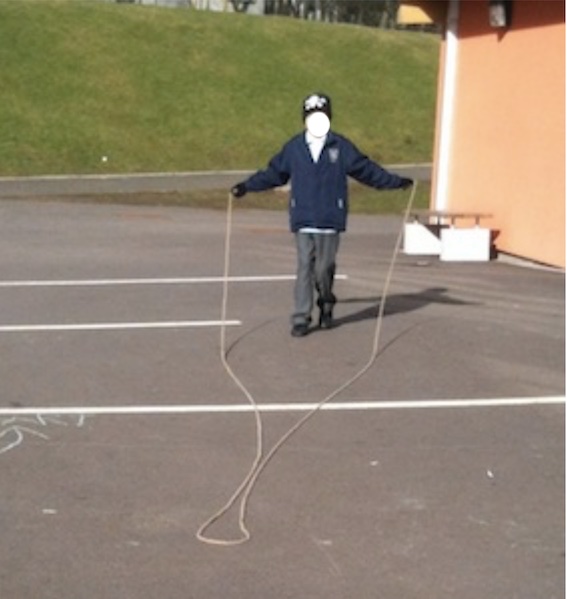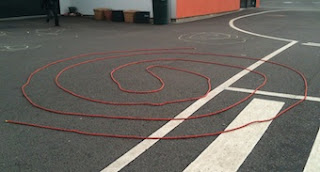A couple of weeks ago, I blogged about a class who explored mazes outside. We continued the investigations and moved on to looking at labyrinths. These are a bit different to mazes. A maze has an element of problem-solving and decision making as usually one has to work out the way through the maze.
A labyrinth is about walking, reflecting and covering a lot of ground in a very short space. There are no dead ends and crossing of paths. The route is pre-determined. There is something very intricate and powerful about many labyrinths and the legends of their use such as Theseus and the Minotaur. Many medieval churches had labyrinths created on their floors and emphasised the spiritual benefits of walking labyrinths.

We began by using ropes. I thought this might help in that ropes being one continuous line, would enable the class to focus on the rope pattern rather than doing something that was more of a maze. I encouraged the children to fold a rope in half and use this to create a path. I thought this might help too.
One child who was absent when we experimented with mazes managed to make this! He particularly enjoyed the line work and walking through everyone else’s mazes too.

Two children with the biggest rope created a mythical creature. Rope work does lend itself naturally to children working together.

I was told to stand on a nearby bench to get the full effect of their work. Everyone had to walk from the tail to the beak.

Two other children understood the concept of a spiral labyrinth. This was created by standing in the centre and winding a folded rope around the centre. Mathematically their work is very interesting. First of all, it can be surprisingly hard to estimate where the exact halfway point or centre actually is. There is an element of illusion to spiral labyrinths.

Next there are two entry/exit points. The children spent a long time trying to work out if both paths to the centre were the same distance. This included some fun races and using a stopwatch to time each other.

From the rope work, some children moved on to using chalk. This is more challenging as mistakes cannot be so easily rectified. This child began with a simple spiral.

However, he clicked about the double ropes and unlike last week’s line mazes, this “Curly Wurly” labyrinth has two lines. A definite step-forward in his thinking and understanding.

This activity is simple to undertake and a good example of how investigations can be undertaken outside with children of all ages and abilities. I’ve previously blogged about the spiritual aspect of labyrinths which adds more purpose and a different dimension to labyrinth work.
This blog post was originally published in March 2012.




















I love the ideas about mazes and labyrinths. Will definitely try these out. Might try them in the woods too.
Yes – the concept works anywhere. What is good is the level of freedom it gives children to be creative. I think this works better than getting a maze put down as a playground marking or more formal structures – unless it’s a labyrinth that’s cleverly integrated into a path system.